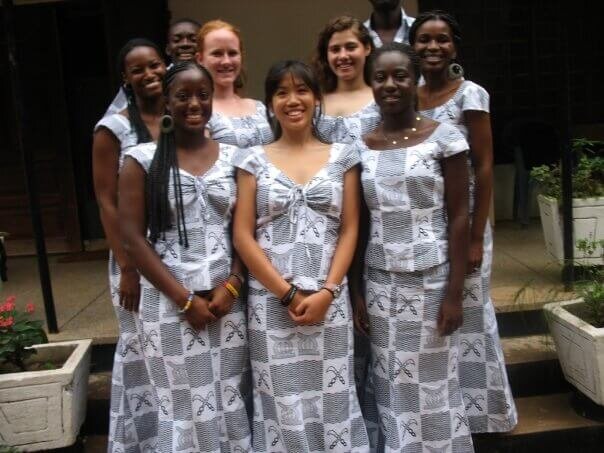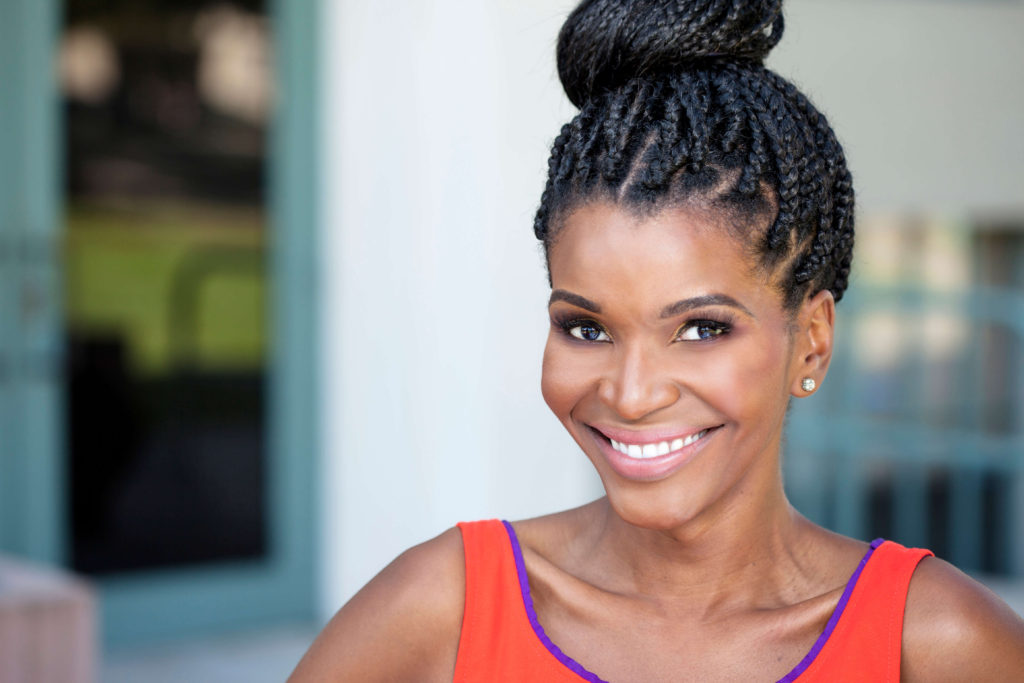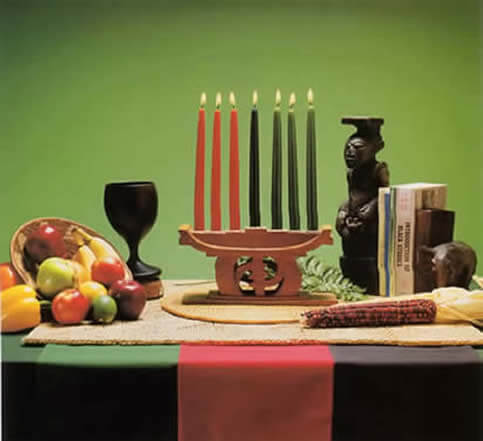
[Photo: from a trip that the author (top right) took with her friends to Kumasi, Ghana, to connect with her roots and learn more about Ghanaian culture and history]
Most people in the United States are most likely familiar with Hanukkah and Christmas, whether they celebrate them or not, but probably know much less about Kwanzaa. No worries: since I celebrate Kwanzaa, let me drop some Kwanzaa knowledge on you so that the next time someone mentions the holiday, you’ll have some real knowledge to contribute to the conversation. Here’s a fun Q&A: consider it Kwanzaa 101.
What exactly is Kwanzaa?
Created by Dr. Maulana Karenga in 1966, Kwanzaa celebrates foundational values of African culture that build and reinforce family, community, and culture among African Americans and Africans throughout the world.
Each day in the seven-day celebration, which runs December 26 to January 1 every year, emphasizes one of seven principles, known as Nguzo Saba. Here they are, in English and Swahili, with a handy phonetic pronunciation guide:
- Unity: Umoja (oo–MO–hah): To strive for and maintain unity in the family, community, nation, and race.
- Self-determination: Kujichagulia (koo–gee–cha–goo–LEE–yah): To define ourselves, name ourselves, create for ourselves, and speak for ourselves.
- Collective Work and Responsibility: Ujima (oo–GEE–man): To build and maintain our community together and make our brother’s and sister’s problems our problems and to solve them together.
- Cooperative Economics: Ujamaa (oo–JAH–man): To build and maintain our own stores, shops, and other businesses and to profit from them together.
- Purpose: Nia (nee–YAH): To make our collective vocation the building and developing of our community in order to restore our people to their traditional greatness.
- Creativity: Kuumba (koo–OOM–bah): To do always as much as we can, in the way we can, in order to leave our community more beautiful and beneficial than we inherited it.
- Faith: Imani (ee–MAH–nee): To believe with all our heart in our people, our parents, our teachers, our leaders, and the righteousness and victory of our struggle.
(See below for more info on how these principles are invoked during Kwanzaa celebrations.)
Who is Dr. Karenga, and why did he start Kwanzaa?
Dr. Maulana Karenga is Professor and Chair of Africana Studies at California State University, Long Beach. After having joined the Black Liberation Movement in the 1960s, he founded Kwanzaa to give African Americans and Africans worldwide a way to connect to their African heritage, to each other, and to communitarian and African values—things which have been impeded due to the pervasiveness of slavery and colonialism worldwide.
So he made up a holiday?
Yep! However, unlike Christmas and Hanukkah, Kwanzaa is not a religious holiday: it’s a cultural holiday that can be celebrated by anyone, whether they are religious or not. This year marks its 50th anniversary, and it’s celebrated by millions of people worldwide, which includes those living on the continent of Africa, those of African descent living throughout the globe, and African Americans.
Do all African Americans celebrate it?
Nope. Some (usually the most socially-conscious) celebrate it formally. Many, however, celebrate it informally throughout the year by connecting with their African heritage, building up the community, mentoring youth, and supporting businesses and organizations within the Black community.
Is there some sort of special preparation?
Yes, and it’s kind of detailed due to all of the cool symbols. First, prepare a table in your home or the space where you will celebrate. The picture above illustrates how the table is to be prepared.
- The Mat symbolizes our tradition and history, which are our foundation.
- The Crops symbolize African harvest celebrations and represent the rewards of productive, collective labor.
- The Candle Holder symbolizes our roots, our collective parents—continental Africans.
- The Corn symbolizes our children and their embodiment of our future.
- The Seven Candles symbolize the Nguzo Saba (the Seven Principles), the set of values which African people are urged to live by.
- The Unity Cup symbolizes the foundational principle and practice of unity, without which nothing else is possible.
- The Gifts symbolize the labor and love of parents and the commitments to be kept by their
So what happens during each of these seven days? Do you use the items on the table?
Let’s break it down, day by day:
Day 1 – Light the black candle for Unity (Umoja) that sits on the Candle Holder (Kinara). Choose one of the following activities to commemorate Kwanzaa. Activities may include:
- Discussions about the principle for that day
- Drumming and musical selections
- Other artistic performances
- Reflections on the Pan-American colors (red, green, black)
- Readings from books that detail African history
Day 2 – Light the far left red candle for Self-determination (Kujichagulia), and celebrate with an activity.
Day 3 – Light the far right green candle for Collective Work and Responsibility (Ujima), and choose an appropriate activity.
Day 4 – Light the second red candle for Cooperative Economics (Ujamaa), and select an activity.
Day 5 – Light the second green candle for Purpose (Nia), and choose a celebration activity.
Day 6 – The Kwanzaa Karamu (Feast) takes place December 31. To begin, light the last green candle for Faith (Imani), and then place the food on the Mat (Mkeka). Finally, pass the Unity Cup (Kikombe cha Umoja) to each person, ending with the eldest person, who will ask for a blessing from the ancestors. The drink is usually water, juice or wine. The feast should be accompanied by an activity as well.
Day 7 – Light the last green candle for Faith (Imani), and give out the Zawadi (The Gifts). Traditionally gifts are exchanged between parents and children, but should be homemade. Ideally they are educational or artistic in nature. These gifts are given on this first day of the New Year, with the expectation that the recipient will give back to the community throughout the year. On this day of meditation, all celebrants reflect on the prior year and the coming year, and reaffirm their commitment to the well-being of the community.
Although Kwanzaa officially lasts for only one week, its principles are to be lived out every day throughout the year.
Wow, that’s a lot of symbolism, but it’s pretty cool. Can I celebrate even if I don’t have African roots?
Absolutely. Just don’t do it to show how “down with African culture” you are. Start by learning parts of African history. Study communitarian African values, and then look for ways you can embrace community more. Lastly, support black businesses and organizations that serve African American youth. This is a way that you can practice Nguzo Saba principles, like Unity, Collective Work and Responsibility, and Cooperative Economics.
Anything else I need to know?
Our country needs the spirit and values of Kwanzaa today perhaps more than ever before. We need people who will extend hands across culture and religion and class to learn about others and do unto others. We need people who will interact cross-culturally, even at the risk of not doing it perfectly. This Kwanzaa, I hope that you will take a chance to embrace unity in big and small ways.
Oh, and if you do happen to attend a Kwanzaa celebration… the appropriate greeting for someone who doesn’t have African roots is, “Joyous Kwanzaa!”
Wait, so there are special greetings for Kwanzaa, too?
Yep! African Americans greet each other with “Habari gani?,” which means, “What is the news?” in Swahili. The answer is whatever Nguzo Saba principle is the focus for that day, meaning, “Imani,” “Umoja,” and so forth.
Thanks for explaining all of this.
You’re welcome. Thanks for reading. In the spirit of Umoja, share this blog with a friend or family member whom you think would appreciate it. Maybe they’ll join the celebration.
 Chanté Griffin is a Los Angeles-based writer and performer. She attended Pomona College and Spelman College as a Media Studies major where she studied how TV, film and other media construct and intersect with race, culture and gender. She’s written for The Root, EBONY.com, Los Angeles Magazine and Daily Actor. Additionally, she is the creator of YouTube’s 14 Days of Funny. Her work is socially conscious and soul conscious.
Chanté Griffin is a Los Angeles-based writer and performer. She attended Pomona College and Spelman College as a Media Studies major where she studied how TV, film and other media construct and intersect with race, culture and gender. She’s written for The Root, EBONY.com, Los Angeles Magazine and Daily Actor. Additionally, she is the creator of YouTube’s 14 Days of Funny. Her work is socially conscious and soul conscious.



Grok Nation Comment Policy
We welcome thoughtful, grokky comments—keep your negativity and spam to yourself. Please read our Comment Policy before commenting.